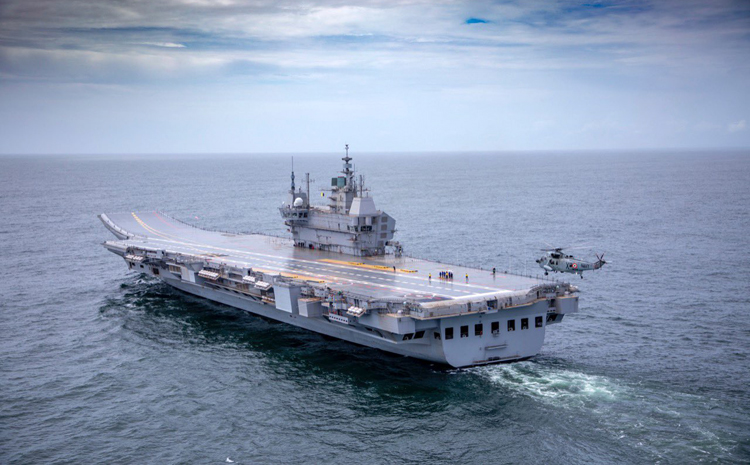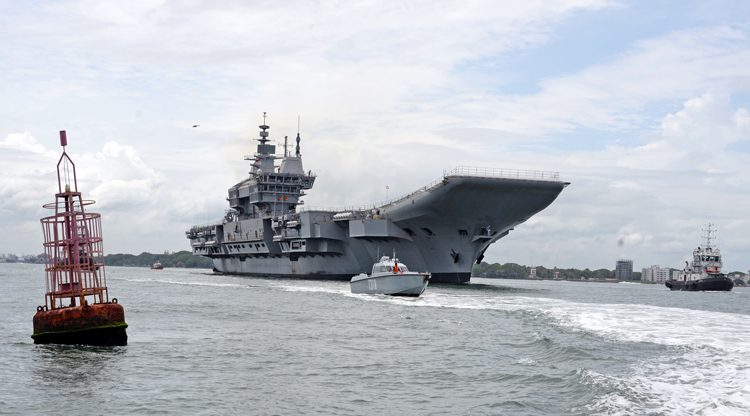INDIAN ARMED FORCES CHIEFS ON OUR RELENTLESS AND FOCUSED PUBLISHING EFFORTS

The insightful articles, inspiring narrations and analytical perspectives presented by the Editorial Team, establish an alluring connect with the reader. My compliments and best wishes to SP Guide Publications.

"Over the past 60 years, the growth of SP Guide Publications has mirrored the rising stature of Indian Navy. Its well-researched and informative magazines on Defence and Aerospace sector have served to shape an educated opinion of our military personnel, policy makers and the public alike. I wish SP's Publication team continued success, fair winds and following seas in all future endeavour!"

Since, its inception in 1964, SP Guide Publications has consistently demonstrated commitment to high-quality journalism in the aerospace and defence sectors, earning a well-deserved reputation as Asia's largest media house in this domain. I wish SP Guide Publications continued success in its pursuit of excellence.
- Global Partners Urged to Tap India's Shipbuilding Potential: Rajnath Singh at Samudra Utkarsh
- All about HAMMER Smart Precision Guided Weapon in India — “BEL-Safran Collaboration”
- India, Germany deepen defence ties as High Defence Committee charts ambitious plan
- G20 Summit: A Sign of Global Fracture
- True strategic autonomy will come only when our code is as indigenous as our hardware: Rajnath Singh
- India–Israel Joint Working Group Meeting on defence cooperation to boost technology sharing and co-development
Vikrant on Sea Trials
Vikrant is also known as the Indigenous Aircraft Carrier 1, or IAC-1. It will be the second ship to bear the name 'Vikrant'. The first Vikrant was the first aircraft carrier of the Indian Navy that served in the 1971 Bangladesh war and was decommissioned in 1997.
 |
The Author is Former Director General of Information Systems and A Special Forces Veteran, Indian Army |

August 4, 2021 was a proud day for all Indians as the first indigenous aircraft carrier INS ‘Vikrant’ set out into the Arabian Sea with 1,500 officers and sailors on board for four days of sea trials. The spokesperson of Indian Navy tweeted, “Proud & historic day for India as the reincarnated Vikrant sails for her maiden sea trials today, in the 50th year of her illustrious predecessor’s key role in the 1971 war. Largest and most complex warship ever to be designed and built in India. Many more will follow.”
Defence Minister Rajnath Singh had already said that Vikrant, expected to be commissioned into service next year, will add superior combat capability, range, and versatility to the Navy. He also added that this will be a tribute to 75 years of India’s Independence. The project to build the aircraft carrier ‘Vikrant’ cost 24,000 crore (about $3.5 billion). It was originally targeted for commissioning in 2018 but was delayed due to the pandemic. India currently has one aircraft carrier, INS ‘Vikramaditya’, inducted from Russia in 2013.
It is the largest and most complex warship ever to be designed and built-in India
Vikrant is also known as the Indigenous Aircraft Carrier 1, or IAC-1. It will be the second ship to bear the name ‘Vikrant’. The first Vikrant was the first aircraft carrier of the Indian Navy that served in the 1971 Bangladesh war and was decommissioned in 1997. Having built IAC-1, India has joined the select group of nations having niche capability to indigenously design, build and integrate a state-of-the-art aircraft carrier. Constructed by the Cochin Shipyard Limited for the Indian Navy, work on the ship's design began in 1999, and the keel was laid in February 2009. The carrier was floated out of its dry dock on December 29, 2011, and was launched on August 12, 2013.
The basic trials of Vikrant were completed in December 2020. The length of the ship is 262 metres, while its beam is 62 metres and has a depth of 25.6 metres. It is the largest and most complex warship ever to be designed and built-in India. Having a displacement of over 40,000 tons, Vikrant is expected to carry 24 x Russian-built MiG-29K fighter jets and a combination of helicopters including the Ka-31 for airborne early warning, MH-60R for anti-submarine warfare and HAL Dhruv for general-purpose duties like search and rescue. Vikrant will use the same ‘ski-jump’ configuration as the INS Vikramaditya to launch fighter aircraft but is considerably more advanced than the Russian-built Vikramaditya. Moreover, Vikrant features newer engines, radars and other electronics compared to the Vikramaditya.
With increasing territorial disputes worldwide, aircraft carriers acting as command and control of a naval fleet in times of war and peace are high-value warfare assets
Since 1985, China acquired decommissioned aircraft carriers from Australia (British built HAMAS ‘Melbourne’) and Soviet carriers ‘Minsk’, ‘Kiev’ and ‘Varyag’. Subsequently, ‘Varyag’ underwent extensive refit and was converted into China’s first operational aircraft carrier named ‘Liaoning’. Liaoning also was the basis for designing China’s subsequent aircraft carriers.
As of 2018, the PLA Navy (PLAN) had two combat-ready aircraft carriers, the ‘Liaoning’ and ‘Shandong’, with the third under construction. Work on the third aircraft carrier began in 2018 but satellite imagery of May 2021 shows considerable progress. A 2021 report by the US Department of Defence (DoD) on the Chinese military had said that this will likely be the largest aircraft carrier and fitted with a catapult launch system. The recent satellite imagery confirms this earlier assessment.
The Centre for Strategic and International Studies (CSIS) estimates that the length of the China’s third aircraft carrier is approximately 318 metres, making it larger than both of its predecessors, Liaoning and Shandong. The superstructure, also known as the island, is smaller, leaving more room on the flight deck for a larger air component. It is projected that China may possess five or six aircraft carriers by the 2030s; two for Western Pacific, two in the Indian Ocean Region (IOR) and one as reserve. The sixth may be due to China’s growing interest in Africa.

There has been discussion about requirement of a third aircraft carrier for India but the issue is apparently shelved for the present because of finances required for it, much that the Navy wants it given that one each are essential for the eastern and naval fronts and at a time when one of the two aircraft carriers has to go through maintenance and refit, only one will be operational. Not that there is dearth of money in India - government has revealed Air India accumulated losses of 70,820 crore till March 31, 2020 which could have easily equipped the navy with another two aircraft carriers.
The opposing view is that a third aircraft carrier is not required because Andaman and Nicobar Islands itself is a large floating aircraft carrier which can be military-sized in addition to other island territories similarly. But with increasing territorial disputes worldwide, aircraft carriers acting as command and control of a naval fleet in times of war and peace are high-value warfare assets; floating airbases equipped with full-length flight deck capable of carrying, arming, deploying and recovering aircraft.
A good new related to boosting the combat capability of the IN is that the US has cleared the sale of Harpoon Joint Common Test Set (JCTS) and related equipment to India for an estimated cost of $82 million. Harpoon is an anti-ship missile. The Government of India has requested to buy one Harpoon JCTS. Harpoon JCTS also includes one Harpoon Intermediate Level maintenance station; spare and repair parts, support, and test equipment; publications and technical documentation; personnel training; US Government and contractor technical, engineering, and logistics support services; and other related elements of logistics and programme support.
As of 2018, the PLA Navy (PLAN) had two combat-ready aircraft carriers, the ‘Liaoning’ and ‘Shandong’, with the third under construction
The Pentagon has said that India will have no difficulty absorbing this equipment into its Armed Forces and the proposed sale of this equipment and support will not alter the basic military balance in the region. Pentagon has also said, “The principal contractor will be The Boeing Company, St. Louis, Missouri. There are no known offset agreements proposed in connection with this potential sale. Any offset agreement required by India will be defined in negotiations between the purchaser and the contractor(s)."
The Harpoon, first deployed in 1977, is an all-weather, over-the-horizon, anti-ship missile system. It has a low-level, sea-skimming cruise trajectory with active radar guidance, according to Boeing. Presently, the Harpoon anti-ship missile is in service with armed forces of more than 30 countries. Harpoons will improve India's capability to meet current and future threats given the flexibility and efficiency of these ant-ship missiles and maintenance capabilities being acquired to ensure maximum force readiness.





